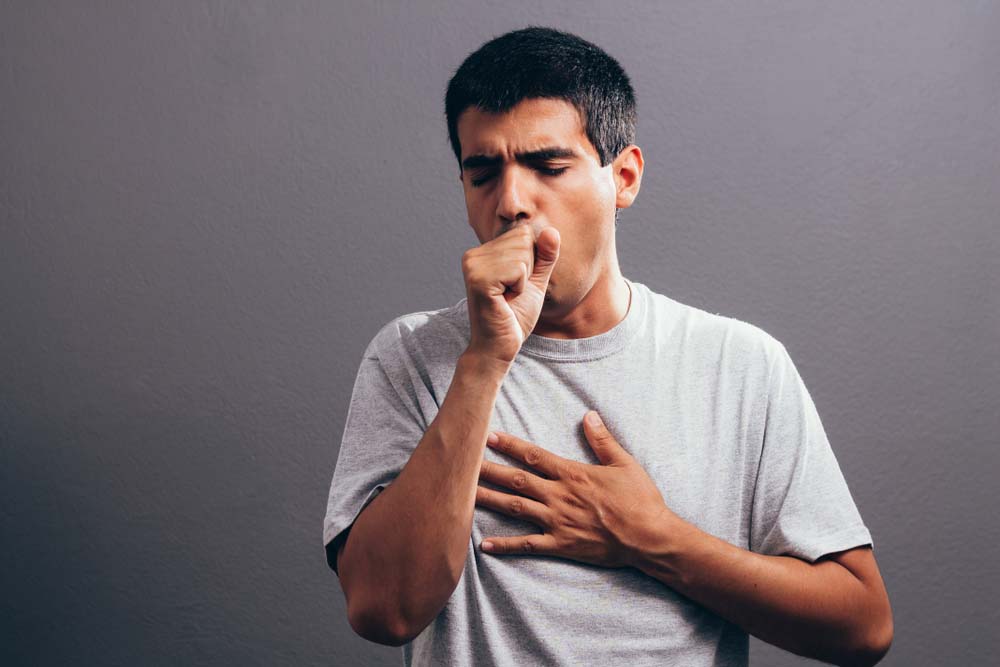Signs and symptoms of lung cancer

Clinical features of lung cancer depend on the site of the lesion, the invasion of neighboring structures, and extent of metastases. Common symptoms include a persistent cough, weight loss, shortness of breath and non-specific chest pain.
- Hemoptysis, or coughing up blood occurs in fewer than 50% of patients presenting symptoms for the first time. It appears when the tumor starts to affect the microvasculature of the lungs.
- Cough, commonly described as an unusual or changed cough, is a common presentation. Tumor cells irritate the mucosal linings in the bronchioles or the alveoli.
- Severe localized pain suggests chest wall invasion, and a likely infiltration of an intercostal nerve. Invasion of the apical area may involve the brachial plexus leading to the Pancoasts syndrome. This syndrome is characterized by severe pain in the shoulder and down into the inner surface of the arm. It gets worse upon breathing, coughing or laughing.
- Dyspnea may come from the loss of functioning of the lung tissue, after lymphatic invasion or through the development of a large pleural effusion. This can result in difficulty to exchange oxygen and CO2.
- Pleural fluid is an ominous feature, and the presence of blood in a pleural effusion suggests that the pleura has been directly invaded. Buildup of pleural fluid can cause difficulty to breathe, and it needs to be drained out immediately.
- Digital clubbing and hypertrophic pulmonary osteoarthropathy accompany some lung cancers, and may resolve with the excision of the primary lesion.
- Hoarseness may result due to invasion of the mediastinum, leading to the damage of the recurrent laryngeal nerve.
- Dysphagia is usually due to the involvement of the esophagus from extrinsic pressure. This can happen when tumor grows in size leading to compression on the esophagus.
- Raised jugular venous pressure may arise because of superior vena cava obstruction. Swelling in the face and the neck starts to appear because the tumor is putting pressure and not allowing correct blood circulation. Discoloration may appear because of venous blood engorgement.
- Myopathies (problems in the muscle tissue) appears in patients with lung cancer due to the association of small cell carcinoma with the Eaton Lambert syndrome. In these cases, our own immunity attacks the central nervous system resulting in such myopathies. It can result in difficulty to sit or stand.
- Horner syndrome is another clinical problem that may arise in these patients. It features ptosis (drooping of the eyelids), miosis(small pupils), and anhidrosis(loss of sweating in the face on the affected side). It is due to the involvement of the inferior cervical ganglion and the paravertebral sympathetic chain.
- Infections in the respiratory tract are more common, especially bronchitis and pneumonia. All of this happens because tumor cells affect the immunity in the ecosystem of the lungs.
- Wheezing symptoms can appear due to damage in the airways.Paralysis of the ipsilateral hemidiaphragm appear due to a direct invasion to the phrenic nerve.
- Unexplained weight loss can happen because of a chemical disruption in the metabolic system and increased calorie output because the cancer cells use too much energy to keep growing.
- Bone pains can also occur, especially in the hips or back due to metastasis of the tumor to the bones. Tumor cells attack the osteocytes and start to break them, increasing the susceptibility to fractures.
- Distant metastases to the liver are associated with asthenia and weight loss. It also compromises liver functions leading to discoloration of eyes and skin. Brain metastases (10% in NSCLC, more common in adenocarcinoma, and 20–30% in SCLC) may present with symptoms such as headache, nausea, vomiting, seizures, dizziness, or altered mental status.

